Deer Resistant Plants
Are there deer resistant plants? Well...yes...and no...
Deer - chowing down…
There are some plants that have a higher probability of being resistant but hungry animals will eat things they normally wouldn’t. And young deer often need to taste things (sometimes multiple times... grrr...) before they decide they don’t like them.
Another complicating factor – some things avoided by deer are loved by rabbits. Gardening is not for the faint of heart.
So what is a gardener to do?
Generally animals will avoid plants that are smelly (minty, herbal, citrusy) or uncomfortable (spiky, fuzzy) or poisonous. Placing plants like these in high deer traffic areas can help reduce damage.
There are lists of resistant plants available, often based on other’s experiences. They are a good place to start. If you have other gardeners in your neighborhood they can be a great resource in identifying what works with your local critter population.
Below I’ve compiled a partial list of native plants known to be deer resistant. At the end of the post I’ve also included some links to additional critter resistant plant lists. Finally, I’ve included a link to a comparative study of deer repellent sprays in case you would like to include them in you deer management strategy.
Don’t let those critters take the fun out of gardening!
Mid-Atlantic Native Deer Resistant Plants – a partial list
Trees
Sassafras tree
American Beach (Fagus grandifolia)
American Holly (Ilex opaca)
Bald Cypress (Taxodium distichum)
Black Gum (Nyssa sylvatica)
Eastern Red Cedar (Juniperus virginica)
Flowering Dogwood (Cornus florida)
Honey Locust (Gleditsia triacanthos)
Paw-Paw (Asimina triloba)
Sassafras (Sassafras albidum)
Serviceberry (Amelanchier spp.)
Sweetbay Magnolia (Magnolia virginica)
Sweetgum (Liquidambar styriciflua)
Sycamore (Platanus occidentalis)
Shrubs
Fothergilla blossoms
American beautyberry (Callicarpa americana)
American elderberry (Sambucus canadensis)
Arrowwood viburnum (Virburnum dentatum)
Button Bush (Cephalanthus occidentalis)
Fothergilla (Fothergilla gardenii)
Inkberry holly (Ilex glabra)
Mountain laurel (Kalmia latifolia)
Red Osier Dogwood (Cornus sericea)
Spicebush (Lindera benzoin)
Sweet Pepperbush (Clethra alnifolia)
Herbaceous Plants
Tiarella blooms…
Black Cohosh (Actaea racemosa)
Black-eyed Susan (Rudbeckia hirta)
Bleeding Heart (Dicentra exemia)
Butterfly Weed (Asclepias tuberosa)
Christmas Fern (Polystichum acrosticoides)
Columbine (Aquilegia canadensis)
Culver’s Root (Veronicastrum virginicum)
Foam Flower (Tiarella cordifolia)
Golden Ragwort (Packera aurea)
Hayscented Fern (Dennstaedtia punctilobula)
Jack-in-the-Pulpit (Arisaema triphylum)
Lady Fern (Athryrium felix-femina)
Ostrich Fern (Matteuccia struthiopteris)
Purple Coneflower (Echinacea purpurea)
Royal Fern (Osmunda regalis var. spectabilis)
Rue Anemone (Thalictrum thalictroides)
Swamp Milkweed (Asclepias incarnata)
Threadleaf Coreopsis (Coreopsis verticillata)
White Wood Aster (Eurybia divaricata)
Wild Ginger (Asarum canadense)
Wood Fern (Dryopteris marginalis)
Grasses
Sea oats…
Bluestems (Andropogon spp.)
Indiangrass (Sorghastrum nutans)
Little Bluestem (Schizachyrium scoparium)
Pennsylvania Sedge (Carex pennsylvanicum)
Purple Lovegrass (Eragrostis spectabilis)
Sea Oats (Chasmanthium latifolium)
Soft Rush (Juncus effusus)
Switchgrass (Panicum virgatum)
These resources have more complete lists including non-native plants:
Landscape Plants Rated by Deer Resistance – Rutgers University
Deer-Tolerant Ornamental Plants – University of Georgia
Pennsylvania Game Commission Deer Resistant Plants listed by use in the landscape
Lists of Rabbit Resistant Plants
Penn State Rabbit-Resistant Garden and Landscape Plants listed by growing conditions
Iowa State University - Susceptibility of Plants to Rabbit Damage listed by plant type
Information on Deer Repellents:
Alabama Extension: An Overview and Cost Analysis of Deer Repellents for Homeowners





